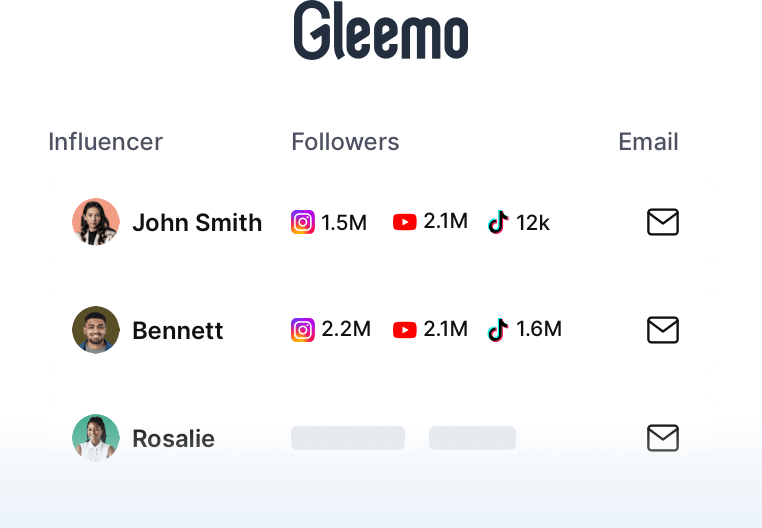Influencity is a comprehensive influencer marketing platform designed to streamline influencer discovery, campaign management, and analytics. Founded in 2014, it has evolved from a Twitter-focused tool into a multi-platform solution supporting Instagram, TikTok, YouTube, and Shopify integrations. This review examines Influencity’s capabilities, pricing, and limitations to help businesses determine its suitability for their needs.
Overview of Influencity
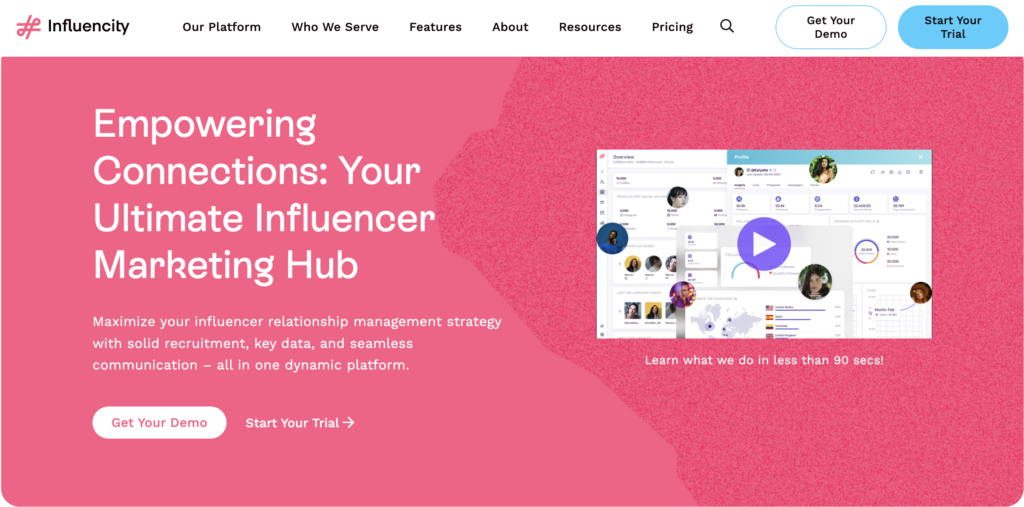
Launched in 2014 as a Twitter-centric tool, Influencity now aggregates data from 200+ million influencer profiles across Instagram, TikTok, YouTube, and Shopify. Trusted by brands like Samsung and agencies like Dentsu, it combines influencer discovery, campaign management, and social media analytics into a unified platform.
Its core focus is delivering granular audience insights and scalable campaign tools for mid-sized to large enterprises. Key industries served include retail, consumer goods, and technology. The platform is particularly suited for brands prioritizing geo-targeted campaigns and data-driven decision-making.
Key Features of Influencity
Influencity offers a robust set of features designed to enhance every aspect of influencer marketing campaigns. Here are the key features that make Influencity an invaluable tool for influencer marketing:
1. Influencer Discovery
Influencity’s influencer discovery tool is one of its core strengths. Users can leverage a wide range of filters to find influencers that match specific criteria, including:
- Audience Demographics: Filter by age, gender, location, and interests to find influencers whose audience aligns with your target market.
- Engagement Metrics: Identify influencers with high engagement rates to ensure you’re partnering with those who can drive real interactions.
- Content Topics: Search for influencers based on the topics they cover, ensuring relevance to your brand or campaign.
- Follower Count: Narrow down influencers by the size of their following, whether you’re targeting micro-influencers or those with larger audiences.
2. Influencer Analytics
Understanding the true impact of an influencer goes beyond just follower counts. Influencity provides in-depth analytics for each influencer profile, including:
- Audience Demographics: Detailed breakdown of the influencer’s audience by age, gender, location, and interests.
- Engagement Metrics: Insights into likes, comments, shares, and overall engagement rates compared to industry averages.
- Content Performance: Analysis of top-performing posts and sponsored content history.
- Fake Follower Detection: Tools to identify accounts with suspicious follower activity, helping brands avoid potential fraud.
3. Influencer Relationship Management (IRM)
Maintaining strong relationships with influencers is essential for long-term success. Influencity’s IRM tool functions similarly to a CRM, enabling users to:
- Organize Influencer Profiles: Add influencers to lists and track important details about each collaboration.
- Track Negotiations: Keep records of negotiations, pricing history, and other key interactions.
- Centralized Communication: While the platform doesn’t offer direct in-platform messaging, it integrates with email tools to facilitate communication.
4. Campaign Management
Managing multiple influencer campaigns can be complex, but Influencity simplifies the process with its campaign management tools. Key features include:
- Bulk Management: Easily manage multiple influencer profiles and campaigns in bulk, saving time and effort.
- Custom Email Templates: Create and send personalized email templates to influencers, streamlining outreach efforts.
- Task Assignment: Assign tasks and track the progress of influencer activities within the platform.
- Shopify Integration: Automate the setup and tracking of sales campaigns, including the creation and distribution of discount codes. While the platform tracks discount code usage, it does not provide monetary values for redemptions, which is a limitation.
5. Result Analytics
Measuring the success of influencer campaigns is crucial for understanding ROI. Influencity offers robust reporting features that allow users to:
- Track Campaign Performance: Generate detailed reports on campaign metrics, including engagement rates, audience growth, and content performance.
- Compare Campaigns: Analyze and compare data from different campaigns to identify what works and what doesn’t.
- Audience Overlap Analysis: Understand how different influencer audiences intersect, helping to optimize future campaigns.
Influencity Pricing
Influencity offers flexible pricing plans to accommodate businesses of different sizes and needs. The plans are structured as follows:
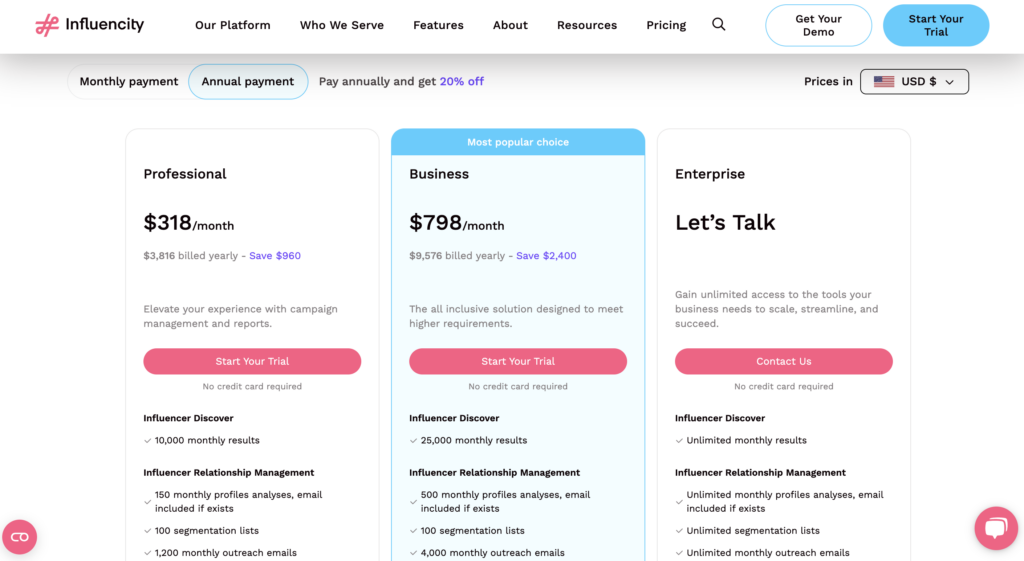
Professional Plan
- Price: $398/month (billed monthly) or $318/month (billed annually).
- Features: 5 users, 10,000 search results/month, 150 profile analyses/month, 1,200 monthly outreach emails, 10 campaigns reports, Shopify integration.
Business Plan
- Price: $998/month (billed monthly) or $798/month (billed annually).
- Features: Unlimited users, 25,000 monthly results, 500 profile analyses/month, 4,000 monthly outreach emails, 50 campaigns reports, social listening, and advanced analytics.
Enterprise Plan
For enterprises with specific needs, Influencity offers customizable plans that can be tailored to include specific features and capabilities. This option provides the flexibility to pay only for the tools and services required.
Target User
Influencity is ideal for:
- Mid-to-Large Enterprises: Brands with budgets for geo-targeted campaigns and Shopify integrations.
- Marketing Agencies: Managing multiple clients with white-label reporting and bulk outreach.
- E-commerce Brands: Tracking promo code redemptions and affiliate sales.
Not Recommended For: Small businesses due to high costs and complexity.
Influencity Pros & Cons
Influencity holds a 4.6/5 rating on G2, reflecting generally positive feedback from users. Understanding the strengths and limitations of Influencity helps brands assess its suitability for their operations:

Influencity Pros
1. Massive Global Influencer Database
- 200M+ Creators: One of the largest databases in the industry, spanning Instagram, TikTok, and YouTube. Ideal for brands targeting global or niche audiences.
- Advanced Filters: Search by location, engagement rate, audience demographics, and authenticity metrics to pinpoint the right influencers.
2. Flexible and Transparent Pricing
- Clear Pricing Tiers: Features and limitations are explicitly outlined for each plan (Professional, Enterprise), avoiding hidden costs.
- Free Trial: A 7-day trial allows users to test features without commitment.
- No Long-Term Contracts: Users aren’t locked into annual agreements.
3. Comprehensive Analytics
Provides detailed insights into influencer performance, including audience demographics, engagement metrics, and fake follower detection.
4. Campaign Management Tools
Streamlines collaboration with influencers, including task assignment, email integration, and real-time post analysis.
Influencity Cons
1. Manual Content Tracking
- No Automation: Users must manually input URLs of influencer posts to track performance. This adds administrative work and delays real-time analytics.
- No Instagram Stories Tracking: Fails to capture ephemeral content, a critical gap for brands leveraging Stories for time-sensitive promotions.
2. Limited E-commerce Integration
- Shopify-Only: While it integrates with Shopify, it lacks connections to WooCommerce, Magento, or BigCommerce.
- No Revenue Attribution: Cannot track sales or ROI directly from influencer campaigns, forcing brands to use external tools.
3. No Campaign Scheduling
Workflow Disruption: Users cannot schedule posts or coordinate timelines within the platform, requiring third-party tools like Hootsuite or Later.
4. No Affiliate Payment Tools
Third-Party Dependency: Brands must handle payments externally, complicating partnerships with affiliate influencers.
Is Influencity Worth It
Influencity excels in geo-targeted influencer discovery, sentiment analysis, and Shopify integrations, making it a strong choice for data-driven enterprises. However, its pricing and complexity may deter smaller teams.
Learn more 👉 Influencity Alternatives.
Explore Gleemo: A Influencity Alternative
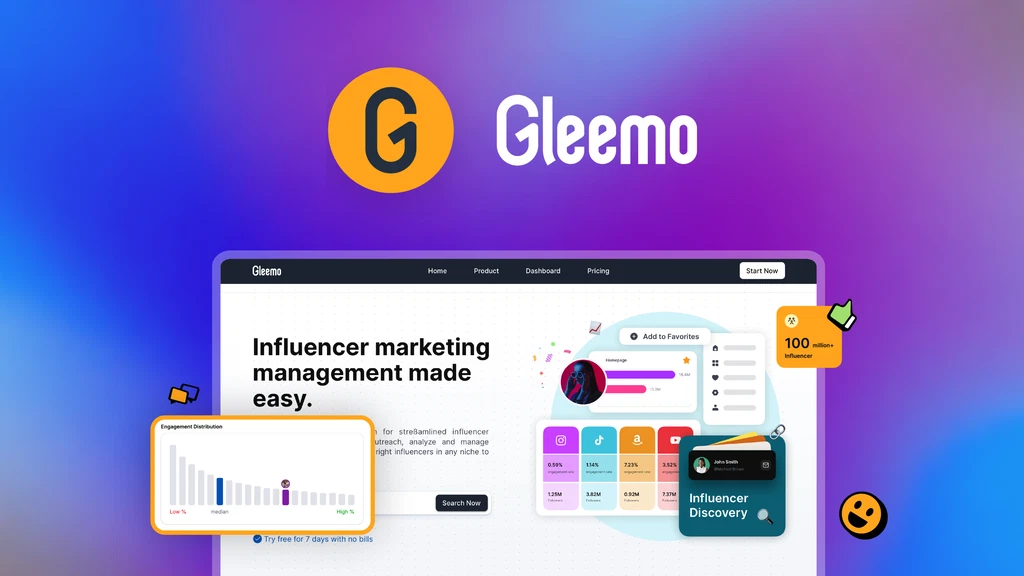
For brands seeking a cost-effective yet powerful alternative, Gleemo offers a compelling solution. Gleemo is an influencer discovery and management platform that leverages AI technology and a vast database of over 100 million influencers across Instagram, YouTube, TikTok, and Amazon.
- AI Semantic Search: Gleemo’s search engine analyzes bios, captions, and hashtags using natural language processing (NLP), identifying influencers based on contextual relevance rather than keyword matching.
- 30+ Advanced Filters: Refine searches using 30+ criteria, including audience interests, engagement trends, and brand affinity.
- Influencer Analytics: Track engagement metrics, audience demographics, and post performance.
- Collaboration Management: Centralized dashboard to track influencer outreach, contracts, and campaign status.
Gleemo Pricing
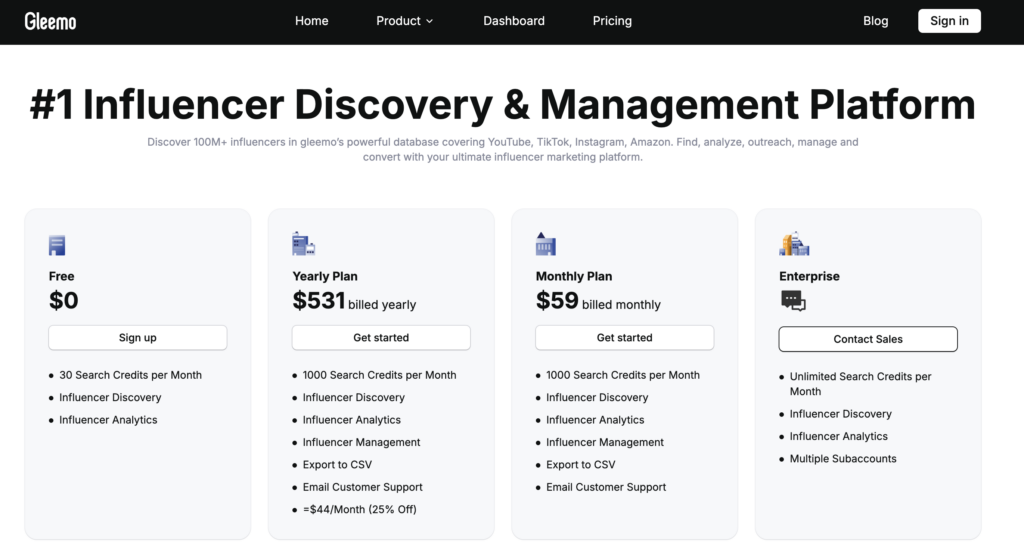
Gleemo provides a free trial with 30 monthly search credits and core analytics, while its budget-friendly paid plans start at $44/month (billed yearly) or $59/month (billed monthly), both offering 1,000 credits and advanced tools like influencer management and CSV exports. This structure balances accessibility for small teams with scalable options for high-volume campaigns.
Target User
Gleemo is ideal for:
- Marketing Agencies: Efficiently filter and contact influencers in bulk.
- Brands: Search for influencers that are the best match and manage collaboration status.
- Creators: Analyze competitors, discover brand partnership opportunities, and gain inspiration for post creatives.
Why Gleemo Stands Out
For businesses prioritizing affordability, flexibility, and cutting-edge AI tools, Gleemo provides a compelling alternative to Influencity.
- Cross-Platform Reach: With 100+ million influencers across Instagram, YouTube, TikTok, and Amazon, Gleemo offers broader platform coverage, ideal for product-based campaigns.
- Intuitive Analytics: Track audience demographics, content performance, and competitor benchmarks in a user-friendly dashboard.
- Micro/Nano Influencer Discovery: AI identifies hidden gems with highly engaged audiences.
- More cost-effective: Gleemo offers monthly subscriptions starting at $59/month, eliminating financial risks for seasonal or experimental campaigns!
Trying Gleemo as an Alternative Right Now
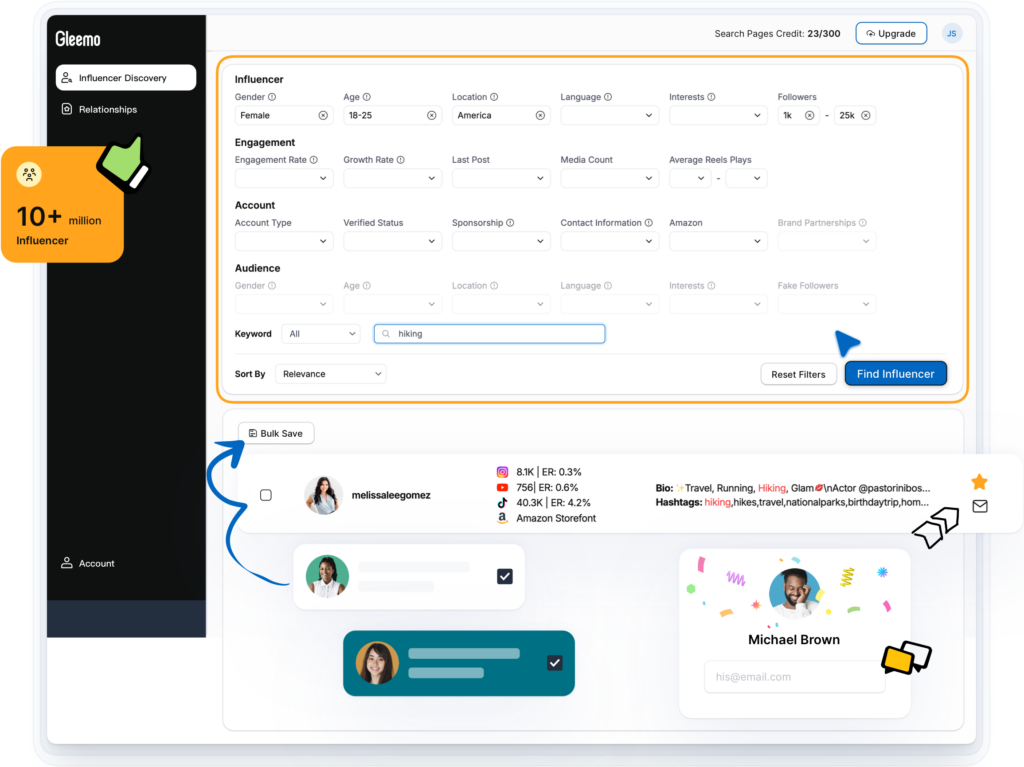
Influencity remains a robust solution for enterprises needing advanced geo-targeting and sentiment analysis. Its Shopify integration and granular filters empower brands to execute localized campaigns effectively. However, the platform’s high cost and lack of Story analytics limit its appeal for smaller teams.
For businesses prioritizing flexibility and AI-driven insights, Gleemo bridges the gap between enterprise-grade tools and accessibility. With its semantic search, vast database, and transparent pricing, Gleemo simplifies influencer discovery and management, enabling brands to focus on creativity over complexity.
💡 Start your free trial with Gleemo today and experience the difference that AI-powered influencer discovery and management can make for your brand.
